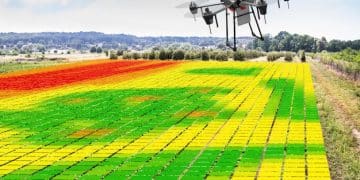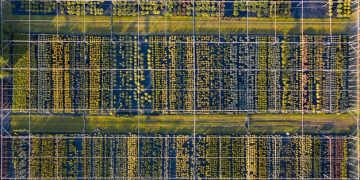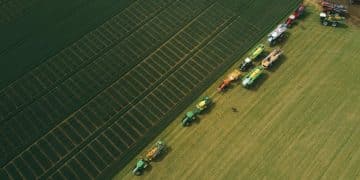Data Analytics for Sustainable Agriculture: Boosting Farm Profitability
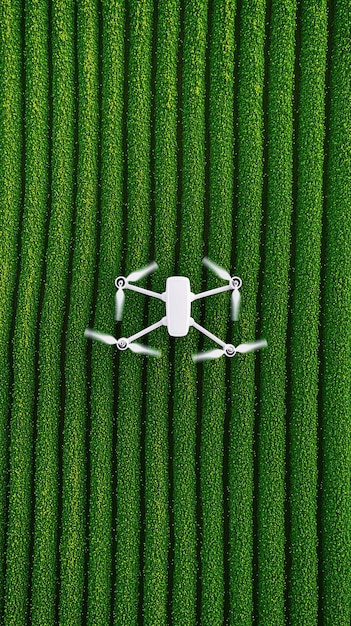
Discover How to Use Data Analytics to Optimize Sustainable Agriculture Practices and Improve Farm Profitability by leveraging precision farming techniques, predictive modeling, and resource optimization through data-driven insights, leading to increased yields, reduced costs, and environmentally responsible farming.
Want to boost your farm’s profitability while embracing sustainable practices? Discover How to Use Data Analytics to Optimize Sustainable Agriculture Practices and Improve Farm Profitability by turning raw data into actionable insights.
Understanding the Role of Data Analytics in Sustainable Agriculture
Data analytics is rapidly transforming various industries, and agriculture is no exception. Applying data analytics to sustainable agriculture creates a more efficient, profitable, and environmentally friendly farming approach.
By leveraging the power of data, farmers can gain deep insights into their operations, enabling them to make data-driven decisions that optimize resource allocation, reduce waste, and enhance crop yields.
What is Data Analytics?
Data analytics involves collecting, processing, and analyzing data to extract meaningful patterns and insights. These insights can be used to improve decision-making and operational efficiency.
In agriculture, data can come from various sources, including weather stations, soil sensors, yield monitors, and drone imagery. Analyzing this data can provide valuable information about crop health, soil conditions, and environmental factors.
Benefits of Data Analytics for Sustainable Agriculture
Using data analytics in sustainable agriculture offers numerous benefits, including:
- Improved Resource Management: Optimizing the use of water, fertilizers, and pesticides based on real-time data.
- Increased Crop Yields: Identifying factors that affect crop growth and implementing targeted interventions.
- Reduced Environmental Impact: Minimizing the use of harmful chemicals and promoting sustainable farming practices.
- Enhanced Profitability: Increasing efficiency and reducing costs through data-driven decision-making.
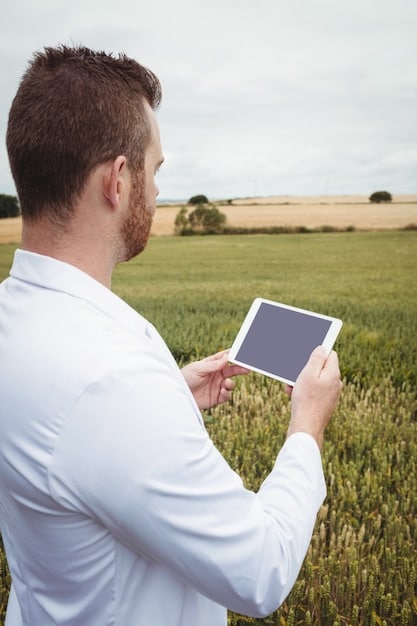
Overall, data analytics empowers farmers to make informed decisions, leading to more sustainable and profitable agricultural practices. By embracing these technologies, the agriculture industry can contribute to a more resilient and environmentally friendly food system.
Collecting Data: Key Sources and Technologies
Effective data analytics begins with collecting high-quality, relevant data. Several sources and technologies are available for gathering agricultural data, each offering unique insights into different aspects of farming operations.
From sensors to drones, these tools provide valuable data streams that can be analyzed to improve decision-making and promote sustainable practices.
Soil Sensors
Soil sensors are devices that measure various soil properties, such as moisture content, temperature, nutrient levels, and pH. These sensors can be buried in the ground or installed on mobile platforms to provide real-time data on soil conditions.
By monitoring soil properties, farmers can optimize irrigation schedules, fertilizer applications, and other soil management practices.
Weather Stations
Weather stations provide essential data on temperature, rainfall, humidity, wind speed, and solar radiation. This information can be used to predict weather patterns, monitor crop water requirements, and assess the risk of pests and diseases.
Combining weather data with crop models can help farmers make informed decisions about planting, irrigation, and pest control.
Yield Monitors
Yield monitors are installed on harvesting equipment to measure crop yields in real-time. These monitors provide data on the quantity and quality of crops harvested from different areas of the field.
Analyzing yield data can help farmers identify areas with high or low productivity, allowing them to implement targeted interventions to improve yields in subsequent seasons.
Drone Imagery
Drones equipped with multispectral or hyperspectral cameras can capture high-resolution images of crops. These images can be used to assess crop health, detect stress, identify nutrient deficiencies, and monitor irrigation effectiveness.
Drone imagery provides a cost-effective way to monitor large areas of farmland and identify potential problems early on.

In conclusion, by leveraging these data sources and technologies, farmers can gather comprehensive information about their operations, paving the way for data-driven decision-making and sustainable agricultural practices.
Analyzing Data: Techniques and Tools
Once data has been collected, it needs to be analyzed to extract meaningful insights. Various data analysis techniques and tools are available to help farmers make sense of their data.
From statistical analysis to machine learning, these methods can uncover patterns, trends, and correlations that can inform decision-making and improve farming practices.
Statistical Analysis
Statistical analysis involves using mathematical methods to summarize and interpret data. Common statistical techniques used in agriculture include regression analysis, analysis of variance (ANOVA), and t-tests.
These techniques can be used to identify relationships between different variables, such as the effect of fertilizer application on crop yield.
Geospatial Analysis
Geospatial analysis involves using geographic information systems (GIS) to analyze spatial data. GIS can be used to create maps of soil properties, crop yields, and other variables.
By overlaying different layers of data, farmers can identify spatial patterns and relationships, helping them to make targeted interventions.
Machine Learning
Machine learning involves using algorithms to automatically learn from data. Machine learning can be used to predict crop yields, detect pests and diseases, and optimize irrigation schedules.
Machine learning models can be trained on historical data to make predictions about future outcomes, helping farmers to make proactive decisions.
Data Visualization Tools
Data visualization tools, such as Tableau, Power BI, and Google Data Studio, can be used to create charts, graphs, and dashboards that make data easier to understand.
These tools allow farmers to quickly visualize patterns and trends in their data, enabling them to communicate their findings to stakeholders.
In short, by embracing these data analysis techniques and tools, farmers can transform raw data into actionable insights, driving more sustainable and profitable agricultural practices.
Implementing Data-Driven Decisions: Best Practices
Data-driven decision-making involves using data to inform decisions about farming practices. By implementing this approach, farmers can optimize resource allocation, reduce waste, and enhance crop yields.
However, successful data-driven decision-making requires careful planning and execution.
Precision Farming Techniques
Precision farming involves using data to tailor farming practices to the specific needs of different areas within a field. This approach can lead to more efficient use of resources and higher crop yields.
For example, variable rate irrigation involves applying different amounts of water to different areas of the field based on soil moisture levels.
Predictive Modeling
Predictive modeling involves using data to forecast future outcomes, such as crop yields, pest outbreaks, and disease epidemics. This information can help farmers make proactive decisions to mitigate risks and maximize profits.
For example, farmers can use weather data and crop models to predict crop yields and adjust their planting and harvesting schedules accordingly.
Resource Optimization
Resource optimization involves using data to allocate resources more efficiently. This can lead to reduced costs and a smaller environmental footprint.
For example, farmers can use soil sensor data to optimize fertilizer applications, reducing the risk of nutrient runoff and water pollution.
- Regular Data Collection: Continuously gather data to track progress and identify new opportunities for improvement.
- Continuous Improvement: Use data to learn from past experiences and refine farming practices over time.
- Collaboration: Share data and insights with other farmers and stakeholders to promote knowledge sharing and collaboration.
In conclusion, by implementing data-driven decisions, farmers can take a more sustainable and profitable approach to agriculture, contributing to a more resilient and environmentally friendly food system.
Case Studies: Success Stories in Sustainable Agriculture
Several farmers have successfully implemented data analytics to optimize their sustainable agriculture practices and improve farm profitability in the US. These case studies offer valuable insights into the practical applications of data-driven decision-making.
Discover how farmers are using data analytics to drive efficiency, reduce waste, and promote environmental stewardship.
Case Study 1: Variable Rate Irrigation
A farmer in California used soil sensors and weather data to implement variable rate irrigation on their almond orchard. By applying different amounts of water to different areas of the orchard based on soil moisture levels, the farmer reduced water consumption by 20% and increased almond yields by 10%.
This approach also reduced the risk of waterlogging and soil salinization, promoting the long-term health of the orchard.
Case Study 2: Precision Fertilizer Application
A farmer in Iowa used yield monitors and soil tests to implement precision fertilizer application on their cornfields. By applying different amounts of fertilizer to different areas of the field based on soil nutrient levels, the farmer reduced fertilizer consumption by 15% and increased corn yields by 5%.
This approach also reduced the risk of nutrient runoff and water pollution, improving water quality in the surrounding area.
Case Study 3: Integrated Pest Management
A farmer in Florida used weather data and pest traps to implement integrated pest management on their citrus groves. By monitoring weather patterns and pest populations, the farmer was able to predict pest outbreaks and apply targeted treatments only when necessary.
This approach reduced pesticide use by 30% and minimized the risk of pesticide resistance, promoting the long-term health of the citrus groves.
In general, these case studies demonstrate the tangible benefits of using data analytics to optimize sustainable agriculture practices and improve farm profitability. By embracing these technologies, farmers can drive efficiency, reduce costs, and promote environmental stewardship.
Challenges and Future Trends in Data Analytics for Agriculture
Using data analytics for sustainable agriculture presents several challenges, including data quality, data integration, and data privacy. Overcoming these challenges is essential for unlocking the full potential of data-driven decision-making.
Explore how these challenges can shape the future of sustainable farming practices.
Data Quality
Data quality refers to the accuracy, completeness, and consistency of data. Poor data quality can lead to inaccurate insights and flawed decisions. To ensure data quality, farmers should invest in reliable sensors and data collection systems.
Farmers must also implement data validation procedures to identify and correct errors.
Data Integration
Data integration involves combining data from different sources into a unified data set. This can be challenging because data may be stored in different formats and use different units of measurement. To overcome this challenge, farmers should use data integration tools that can automatically convert and standardize data.
Standardizing data formats and units of measurement can lead to more accurate and comprehensive insights.
Data Privacy
Data privacy refers to the protection of personal and confidential data. Farmers must take steps to protect their data from unauthorized access and use. This can involve implementing security measures, such as firewalls and encryption, and complying with data privacy regulations.
Ensuring data privacy can build trust with customers and stakeholders.
Future Trends
The future of data analytics in agriculture is likely to be shaped by several trends, including:
- Artificial Intelligence: AI and machine learning will play an increasing role in agricultural data analysis.
- Internet of Things (IoT): The IoT will enable farmers to collect data from a wide range of sensors and devices.
- Cloud Computing: Cloud computing will provide farmers with access to powerful data analysis tools and resources.
- Blockchain: Blockchain technology will enhance supply chain transparency and traceability.
| Key Point | Brief Description |
|---|---|
| 🌱 Soil Sensors | Monitor soil conditions like moisture and nutrients for optimal crop health. |
| 🌦️ Weather Stations | Provide real-time weather data for informed planting and irrigation decisions. |
| 📊 Yield Monitors | Measure crop yields to identify areas for targeted improvements. |
| 🛰️ Drone Imagery | Assess crop health and detect stress using high-resolution drone images. |
FAQ
▼
Sustainable agriculture focuses on farming practices that are environmentally sound, economically viable, and socially responsible. It aims to meet current food and textile needs without compromising the ability of future generations to meet their own needs.
▼
Data analytics can improve farm profitability by optimizing resource allocation, reducing waste, and increasing crop yields. It helps farmers make informed decisions about irrigation, fertilizer application, and pest control, leading to cost savings and higher revenues.
▼
Agricultural analytics uses various types of data, including weather data, soil data, crop yield data, and sensor data from drones and IoT devices. This data is analyzed to gain insights into crop health, soil conditions, and environmental factors affecting farming operations.
▼
The main challenges include ensuring data quality, integrating data from diverse sources, and protecting data privacy. Overcoming these challenges is essential for ensuring that data analytics leads to accurate insights and effective decision-making on the farm.
▼
Future trends include the increasing use of artificial intelligence and machine learning, the expansion of the Internet of Things (IoT) in agriculture, the adoption of cloud computing for data analysis, and the use of blockchain technology for supply chain transparency.
Conclusion
In conclusion, data analytics offers tremendous potential to optimize sustainable agriculture practices and improve farm profitability. By leveraging data-driven insights, farmers can make more informed decisions, leading to increased efficiency, reduced costs, and a smaller environmental footprint. Embracing data analytics is essential for building a more resilient and sustainable food system for future generations.

